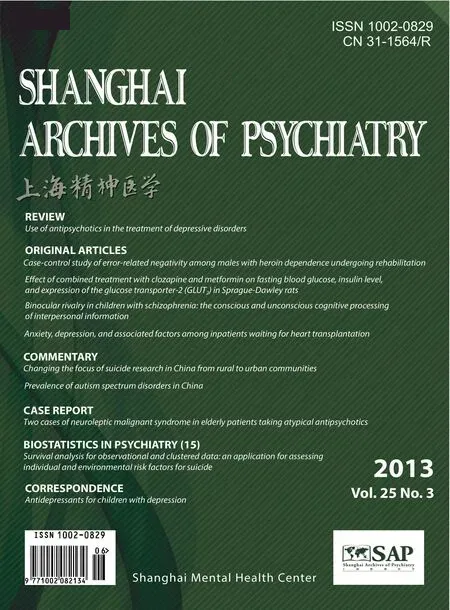Prevalence of ausm spectrum disorders in China
Joseph F. CUBELLS
Joseph F. CUBELLS
The authors conducted an exhausve electronic search of the published literature on ASD prevalence in Chinese-speaking populaons, supplemented by a manual search of references in relevant reports. Very importantly, they included Chinese-language publicaons, thus incorporang several studies that have unl now been inaccessible to the non-Chinesespeaking scholarly community. Following a rigorousa prioriprotocol, they selected appropriate studies, and then evaluated their quality according to the criteria outlined in the STROBE statement.[3]Their procedure excluded numerous studies, notably several registry-based analyses from Taiwan and Hong Kong, which had not included screening procedures in their ascertainment strategies. The degree of heterogeneity in results across the studies was substanal and stascally significant. Even aer exclusion of the largest and only naon-wide study from China, which was found to be a major contributor to overall heterogeneity, theI2stasc remained large (0.76), necessitang applicaons of mixed-effects models in all meta-analyses performed. The result of the main analysis, represenng data from 154,473 individuals, was a pooled mean prevalence of 12.8 per 10,000, substanally lower than current esmates from the West,[4]or from South Korea.[5]Separate analysis of the five studies from mainland China (which included the previously excluded study because its removal did not improve the heterogeneity score) yielded an esmated pooled mean prevalence of 24.4 per 10,000 based on 45,694 persons. The variability of the esmate for mainland China was very high, with the upper limit of the 95% confidence interval for that esmate (57.4 per 10,000) approaching the prevalence reported in Western and South Korean studies. However, the authors found clear evidence for publicaon bias in the mainland Chinese reports, with smaller studies tending to report higher prevalence rates.
The most remarkable result from the analysis is the huge variability of esmates of prevalence, ranging from 1.8 to 426.4 per 10,000. That extraordinary range, together with the observaon that many of the studies reviewed (including those finally used for the metaanalyses) had significant methodological flaws, argues strongly for the need for more research. This need is parcularly evident for mainland China, where the vast majority of Chinese-speaking people live, and where the new Mental Health Law[6]sets the stage for an evidencebased re-working of policy affecng persons with neuro-developmental disorders, their families, and their communies. The observaon that data are available from studies represenng 14,570,369 persons from Hong Kong and Taiwan, but only from 771,413 from mainland China dramazes the urgency of the need for large, rigorous studies in mainland China. Fortunately, high-quality, largescale epidemiological studies of other health issues, such as the impact of using folic acid at theme of concepon on the subsequent incidence of open neural tube defects,[7]have been conducted for many years in China, so the framework for conducng such studies is in place. This inspires hope that the present meta-analysis will spur further rigorous research on the prevalence of ASD in the naon that may soon become the largest economy in the world.
Conflict of interest
The author reports no conflict of interest related to this manuscript.
1. Ronald A, Hoekstra RA. Ausm spectrum disorders and ausc traits: a decade of new twin studies.Am J Med Genet B Neuropsychiatr Genet2011; 156B: 255-274.
2. Wan YM, Hu Q, Li T, Jiang LJ, Du YS, Feng L, et al. Prevalence of ausm spectrum disorders among children in China: a systemac review.Shanghai Archives of Psychiatry2013; 25(2): 70-80.
3. Vandenbroucke JP, von Elm E, Altman DG, Gotzsche PC, Mulrow CD, Pocock SJ, et al. Strengthening the reporng of observaonal studies in epidemiology (STROBE): explanaon and elaboraon.Epidemiology2007; 18: 805-835.
4. Centers for Disease Control. Prevalence of ausm spectrum disorders--Ausm and Developmental Disabilies Monitoring Network, 14 sites, United States, 2008.MMWR Surveill Summ2012; 61: 1-19.
5. Kim YS, Leventhal BL, Koh YJ, Fombonne E, Laska E, Lim EC, et al. Prevalence of ausm spectrum disorders in a total populaon sample.Am J Psychiatry2011; 168: 904-912.
6. Chen HH, Phillips MR, Cheng H, Chen QQ, Chen XD, Fralick D, et al. Translated and annotated version of China’s new Mental Health Law.Shanghai Archives of Psychiatry2012; 24(6): 305-321.
7. Berry RJ, Li Z, Erickson JD, Li S, Moore CA, Wang H, et al. Prevenon of neural-tube defects with folic acid in China. China-U.S. Collaborave Project for Neural Tube Defect Prevenon.N Engl J Med1999; 341: 1485-1490.

Joseph F. Cubells, MD, PhD is an Associate Professor in the Department of Human Genecs and in the Department of Psychiatry and Behavioral Sciences at Emory University School of Medicine, in Atlanta, USA. He is also Director of Medical and Adult Services at the Emory Ausm Center. His experse and interests are in genec factors and gene-environment interacons influencing risk for neurodevelopmental disorders. His currently funded research includes projects on pregnancy-related major depression, posttraumac stress disorder, 22q11 deleon syndrome, and the epidemiology of ausm in China. He has been on the faculty at Emory since 2004, and prior to that was on the faculty at Yale University School of Medicine for nine years. He is on the teaching faculty of the Neuroscience Program and of the Genecs and Molecular Biology Program in the Emory Graduate Division of Biological and Biomedical Sciences, and of the Neuroscience and Behavioral Biology Program of Emory College.
10.3969/j.issn.1002-0829.2013.03.008
Department of Human Genecs and Department of Psychiatry and Behavioral Sciences, Emory University School of Medicine, Atlanta, GA, USA
correspondence: jcubell@emory.edu
- 上海精神醫(yī)學(xué)的其它文章
- Antidepressants for children with depression
- Should repeve Transcranial Magnec Smulaon (rTMS)be considered an effecve adjuncve treatment for auditory hallucinaons in paents with schizophrenia?
- Survival analysis for observational and clustered data: an application for assessing individual and environmental risk factors for suicide
- Changing the focus of suicide research in China from rural to urban communities
- Two cases of neuroleptic malignant syndrome in elderly patients taking atypical antipsychotics
- Anxiety, depression, and associated factors among inpatients waiting for heart transplantation

